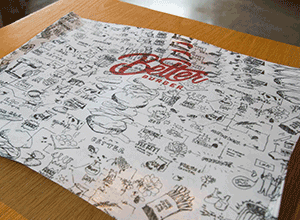Luckily, paper does grow on trees
Sustainability is an increasingly vital issue in all industries. As environmental awareness continues to grow among consumers, brands are racing to merge their commercial goals with greener practices. In fact, many new businesses are being built around sustainability as a primary USP.
The commercial need to ‘go green’ is clearly an urgent one. For the most part, that’s great news. The flipside is that misinformation and hearsay can spread rapidly as some supposedly green trends come into vogue.
For example, the past few years have seen a number of workplaces talk about going paperless in a bid to become more eco-friendly. Paper – and, by extension, printing – still suffers from nasty PR hangover. In reality, paper is one of the world’s truly sustainable products.
Moving beyond the paper myth
Paper’s troublesome reputation is often based on the false assumption that it’s a leading cause of deforestation. Contrary to popular opinion, however, paper production doesn’t destroy forests. Like any other industry, it’s had to adapt to growing demand, becoming more efficient and futureproof in the process.
In Australia and Northern Europe, paper is sourced from planted forests – in other words, trees that are planted for the specific purpose of becoming paper. In these areas, planting, harvesting is strictly controlled. As well as providing a renewable source of wood, planted forests have ecological benefits such as CO2 absorption, oxygen production, reduced soil erosion, and creating wildlife corridors.
Demand for sustainable material means that paper with traceable origins is now standard practice. Paper is not the driver of deforestation that persistent rumours would have us believe. Rather, farming, mining, and property development are the main threats to native habitat.
Thankfully, there are several certification schemes throughout the world ensuring forests are managed sustainably. The two most notable organisations are the Forest Stewardship Council (FSC) and the Programme for the Endorsement of Forest Certification (PEFC).
The versatility of paper
Take it from Patrick Moore, co-founder and former director of Greenpeace, and PhD scientist:
“One of the best ways to address climate change is to use more wood, not less. Wood is simply the most abundant, biodegradable, and renewable material on the planet.”
For starters, paper and cardboard are easily recyclable materials. At the same time, they’re very efficient in terms of being biodegradable. From tree to paper to recycling and, ultimately, to trash, the life cycle of paper is one of the greenest of any material used by humans.
Better Burger & the case for edible packaging
Some brands have approached the need to become greener as a creative challenge. A great example is Better Burger in New Zealand, who used paper as their canvas for a stroke of genius.
To celebrate Earth Day in 2018, customers were served burgers in edible packaging – made from potato starch and water. The paper came complete with Better Burger logo and graphics printed in edible ink.
The campaign encouraged customers to eat everything on their plate, paper and all. And they’re not done yet. Better Burger has teamed up with Innocent Packaging to collaborate long term.
“I’d say we are the only fast food chain in all of Australasia with fully plant-based, compostable packaging so none of our front-of-house waste is sitting in landfill for any great period of time,” said Better Burger General Manager, Rod Ballenden.
The numbers at a glance
Here are some facts and figures to reinforce the paper industry’s claim to sustainability, consider the following:
- 74% of all paper and paperboard in Australia is recycled
- For every tonne of wood a forest produces, it removes 1.47 tonnes of CO2 from the atmosphere and replaces it with 1.07 tonnes of oxygen
- 90% of deforestation is caused by unsustainable agricultural practices (not paper production)
- Between 2005 and 2015, European forests grew by an area the size of Switzerland
- The single biggest cause of tropical deforestation is conversion to cropland and pasture – i.e. farming for food production
- Wood harvest is primarily used for energy (55%) and construction (25%). Paper accounts for only 11%
- Australia recycles 87% of its paper and cardboard, one of the highest rates in the world
What we can all do to be greener
If sustainability is a growing concern for your business, there are steps you can take to improve.
First and foremost, get your recycling game in order. There’s no excuse not to be recycling paper.
Likewise, you can recycle your toner cartridges. A collection program called ‘Cartridges 4 Planet Ark’ is run by Close The Loop. Since the program launched in 2003, they’ve managed to collect 38 million cartridges and keep them out of landfill.
Naturally, any energy you can save through switching off lights and limiting power usage is a big plus. Earth Hour is a concept that’s been gaining support in recent years. While not everyone is as innovative as the Better Burger campaign mentioned above, some companies have taken to closing their stores or office space for the entire day. Maybe a tough sell to your boss but it’s worth a try!
Just remember, next time someone tells you off for your paper usage, you can remind them that, thankfully, paper does, in fact, grow on trees.
Learn more about our approach to sustainability here.

